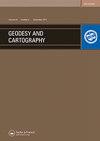Validation of European Gravimetric Geoid models in context of realization of EVRS system in Poland
IF 2.1
Q3 REMOTE SENSING
引用次数: 1
Abstract
: In this study, several variants create and choose of a local quasi-geoid model in Poland have been considered. All propositions have a source in European Gravimetric Geoid models – EGG2008 and EGG2015, which are purely gravimetric models of reference surface. In the course of this work, each model has been analyzed in various ways: without any corrections, by parallel shifting of residuals, by the 7-parameter conformal transformation and by fitting residuals by 4- and 5-parameter trigonometric polynomials. Eventual corrections were based on points of national GNSS/levelling networks (EUVN, EUVN_DA, POLREF, EUREF and ASG-EUPOS eccentric points). As a final result of this study, a comparison of the accuracy of selected models has been carried out by RMSE statistics and maps showing spatial distribution of residuals and histograms. Validation has shown that the maximum achievable accuracy of the EGG models is approximately 2 cm for the ETRF2000 reference system and approximately 8 cm for ETRF89. In turn, fitting with the use of different mathematical methods results in an improvement of the standard deviation of residues to the level of 1.3–1.4 cm. The conclusions include an evaluation of considerations for and against the use of models based only on EGG realizations and, on the other hand, fitted to the points of Polish vertical network. Its usefulness is strictly connected with needs of the definition of up to date quasi-geoid model for the new realization of heights system in Poland, based on EVRF2007 frame.欧洲重力大地水准面模型在波兰EVRS系统实现中的验证
本文章由计算机程序翻译,如有差异,请以英文原文为准。
求助全文
约1分钟内获得全文
求助全文
来源期刊

Geodesy and Cartography
REMOTE SENSING-
CiteScore
1.50
自引率
0.00%
发文量
0
审稿时长
15 weeks
期刊介绍:
THE JOURNAL IS DESIGNED FOR PUBLISHING PAPERS CONCERNING THE FOLLOWING FIELDS OF RESEARCH: •study, establishment and improvement of the geodesy and mapping technologies, •establishing and improving the geodetic networks, •theoretical and practical principles of developing standards for geodetic measurements, •mathematical treatment of the geodetic and photogrammetric measurements, •controlling and application of the permanent GPS stations, •study and measurements of Earth’s figure and parameters of the gravity field, •study and development the geoid models,
 求助内容:
求助内容: 应助结果提醒方式:
应助结果提醒方式:


